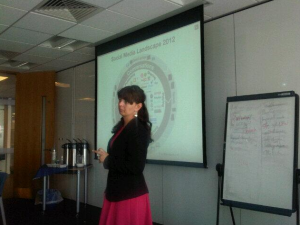During the first two weeks of June, healing Bournemouth University organized over 100 free events as part of the Festival of Learning inviting the residents, NGOs, businesses and supporters of Bournemouth and Dorset to learn more about a wide variety of subject and meet BU’s staff and lecturers. It was a bidding process which got workshops and presentations in the festival and I was lucky to be part of no less than 4 such events and a rerun by popular request all of them dealing with social media in various aspects.
The Social Media Strategy and Monitoring workshops helps on June 11, 14 and 17, my colleague Anna Feigenbaum helping with the delivery of some of them.
 Social Media Strategy
Social Media Strategy
The strategy workshop worked under the premise that a good understanding of everyone’s business model is necessary and fundamental in deciding whether an online presence is appropriate. Inspired in part by Kevin Hoult’s Strategic Planning Worksheet, participants were asked to identify their mission, vision, business revenue model, their best performing products or services as well as their target audiences. This helped identify challenges that our participants faced in real life as well as ask questions about whether social media could help overcome those challenges.
For many businesses and NGOs that rely on a direct contact with their customers and supporters, social media should be an extension of and support their communication and marketing activities. The strategy theorefore for social media needs to connect the busienss objectives with the desired target audiences through the online platforms that best meet those objectives and where the target audiences are active. Kevin Hoult’s page bringing together business objectives and social media options is particularly good and so is Fred Cavazza’s representation of the 2010 social media landscape in identifying the functions that are the core of each platform’s model.
So your strategy planning should include:
- clarification/definition of your mission and vision (of your business in real life) and identification of the product/service and target audience
- definition of your renenue model (and therefore growth revenue model) or identification of the communication activities and their goals
- adaptation of goals in point 2 to social media (here you should ask questions about how what you do in real life can be translated, showcased, supported online).
- creation of social media spefific objectives. For small and medium businesses and NGOs communication and interaction online should ideally convert in tagible business, referrals or funds raised. Communication with smaller, more nieche and more manageable communities is thus more desirable. Chris Anderson’s website TheLongTail has plenty of such examples.
- development of a social media routine and a content plan. The routine should include monitoring of themes and issues related to your business, competitors, your own company as well as of conversations relevant to you. Last year I wrote a whitepaper about how to develop a social media routine which still applies today. Also, two very good examples of a content plan produced by BU students taking the Digital Communication Strategies course can be found on the CMC Student Showcase.
Allow yourself time to test things out. This is why monitoring (see below) is really important.
Social Media Monitoring
Listening to what is said and searched for online is particularly important. Monitoring can be done as a benchmarking exercise, as an exploratory social media audit or as a market research exercise aimed at identifying conversations that one can join and contribute positively to. It can also support identify keywords and search patterns to for better search engine results.
The workshop presented a variety of tools, search and listening platforms. When you check these platforms please read the definitions and explanations they provide about how they generate their results for a better understanding of the data you will get. You can read more about metrics and analytics that matter here and here. Altimeter’s Susan Etlinger’s Framework For Social Analytics is also a great read.
Create your own monitoring plan and dashboard.
A natural continuation of your strategic planning and strategy implementation is to establish a monitoring routine to match your objectives and goals. To be effective you should monitor everything you can in the first instance following to focus your monitoring on matters strictly related to your online objectives. The tools below will enable you to: make your work more efficient and find out where to collect data about your own online activity.
Monitoring search and volume of mentions
- Google Trends – the Explore function will allow you to check and compare searches within Google. There are a variety of filtering options there including country, time, search time (web, image, video) and category. Very useful to see your competitor and related searches an indication into whether what you are searching for is searched by others too. This should make you think about keywords, your company name, spelling and language and memorability of words.
- Google Alerts – email alerts based on keywords that you will receive when content matching your search criteria is uploaded to the internet.
- Social Buzz from Social Searcher for multi-platform searches (includes Facebook, Twitter and Google+).
- Topsy has 2 good features: Social Search and Social Analytics. The experts search within social search is one to test. The Social Analytics feature uses Twitter content only but is good for a 3 keyword/account comparison of volume mentions.
- Social Mention – social search with sentiment analysis.
Monitoring and managing your own accounts
These platforms and apps can help you make your work easiear enabling you to see all at once what happens with all your accounts.
- Hootsuite – online and deskthop based monitoring platform with limited free features. Also includes a click-through analysis. Allows you to manage multiple accounts.
- Yoono – social media monitoring desktop and browser app for Facebook accounts (not pages), Twitter, LinkedIn, Flickr and more.
- Tweetdeck – Twitter desktop and smartphone app. Enables you to monitor, schedule, search and manage twitter accounts.
- TwinitorÂ
- Bufferapp – schedule tweets, measure RTs and clickthroughs. Works with Facebook and LinkedIn as well. Very good measurement tool to indicate virality and interest in what is posted.
Monitoring online influence
Social media influence scores can be tricky especially since there isn’t an agreed definition of what makes an influencer. SocialMediaToday has an interesting webinar on the topic. Using these tools however can show you how conversational you are and with what effect. Since most of them allow you to connect now more accounts, this could be a reminder that an active use of social media contributes to SEO and that social media to be effective needs constant attention.
Monitoring and managing Twitter
- Follower Wonk – great tool to identify where your followers are located as well as compare accounts. This could be the place where you identify other people to follow on twitter that could be relevant, influential and could contribute to your business.
- Twitter Advanced Search – for search of everything within Twitter, including questions and tweets with emoticons. Good for sentiment analysis, identification of conversations that you could potentially join.
- TweetReach – a visualization and calculation of the potential reach of your last tweets. This is about potential virality and the potential numbers of people that could have seen/have been exposed to your message. Similar with Bufferapp but different definitions and visualizations.
Monitoring Facebook
Unlike Twitter where most of the data is in the public domain, monitoring Facebook is not as straighforward and there are less applications available for that. One could use Facebook’s own search function to discover content and pages.
- Facebook Insights – good tool for post by post monitoring. Includes metrics for likes, reach, engaged users, people talking about this and virality. Out of these the people talking about this and engaged users are the ones that matter the most. Demographic data is also included. The number of comments, likes and shares are also displayed on each post.
- EdgeRank Checker
Monitoring YouTube
- YouTube Analytics – very sophisticated monitoring and measurement platform providing a lot of data related to search, users and engagement. Some of the metrics that matter include:
- the fluctuation of subscribers (how to win/lose subscribers; correlate this data with the content you post)
- the likes/dislikes ratio
- the sentiment of comments (ratio of positive/negative)
- subscribers, favorites and shares compared (these are good signs of interest and loyalty)
- video view retention (are your viewers watching the videos in their entirety and if not, what are the most/least viewed parts of the videos)
Check out ZOGDitigal’s blog for more details on how you can optimize you YouTube channel.
Monitoring Pinterest
Pinterest is, to me, a visual bookmarking site using twitter-like metrics as it enables people to follow and be followed, pin and re-pin content, like and comment on content. A high number of repins and shares could be considered a sign of increased popularity of an item or board. On the other hand, a high number of followers might show a high interest into someone’s bookmarking activity.
There are a couple of tools that help track and measure activity on Pinterest. They are:
- Reachli (formely named Pinli) which enables one to measure their virality on pinterest but also monitor, track and manage campaigns associated with financial goals.
- Repinly, a Pinterest directory which displays the most popular board and their associated metrics (topic, number of repins, number of likes, number of comments) which can be helpful when searching for insight or looking for something to benchmark against;
- Pinpuff, Pinterest’s dedicated influence calculator which also includes scores for reach, virality and activity.
More tools and their reviews are available on Econsultancy’s blog.
